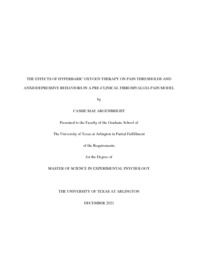| dc.description.abstract | Fibromyalgia (FM) is a chronic, widespread pain disorder generally of a non-inflammatory nature. FM has many known affective and cognitive comorbidities, including fatigue, sleep disturbances, cognitive deficits, and mood disturbances. As a result, FM treatment approaches are mixed in nature and lack a robust characterization that address symptoms on a sensory, affective, and cognitive level. However, there is promise in the implementation of hyperbaric oxygen therapy (HBOT) for alleviating fibromyalgia pain and comorbidities, despite no work investigating the efficacy of this treatment in prominent preclinical FM models. Thus, this project aims to investigate the affective components, specifically anhedonia and anxiety, associated with an acidic saline model of fibromyalgia in rats. Additionally, we seek to find evidence for the potential efficacy of HBOT in the treatment of a pre-clinical model of fibromyalgia and its associated comorbidities.
In this study, forty-eight female Sprague Dawley rats were randomized to a fibromyalgia pain condition or a saline control condition. After verification of the induction of the model using measures of mechanical thresholds, animals were then randomized to receive two 60-minute treatments of hyperbaric oxygen therapy at 2.0 atmospheric absolute (ATA, pressure equivalent to a depth of 33 feet of sea water) or a control treatment with the absence of oxygen/pressure manipulations above 1 ATA (sea level). After the initial treatment session, mechanical thresholds were taken every 24 hours to investigate the effects of hyperbaric oxygen therapy after one session, two sessions, and the period following treatment. Additionally, animals were exposed to an in-cage sucrose preference test for 72 hours, immediately following their second treatment session, to measure between-group anhedonic changes in behavior. 24 hours following treatment, animals were tested for between-group differences using the open-field paradigm, which assessed anxiety-like behavior through changes in locomotion. Results revealed that the acidic saline model was efficacious in replicating pain thresholds indicative of fibromyalgia-like pain. However, data did not provide support for the presence of anxio-depressive comorbidities associated with FM. Additionally, HBOT did not effectively increase mechanical thresholds as expected. Future studies should seek to identify the experimental circumstances within which the negative affective comorbidities associated with FM are presented through the acidic saline model. Additionally, further investigation into the exposure-response relationship between HBOT and the acidic saline model could provide insights into the mechanisms under which this preclinical representation of FM operates. | |


